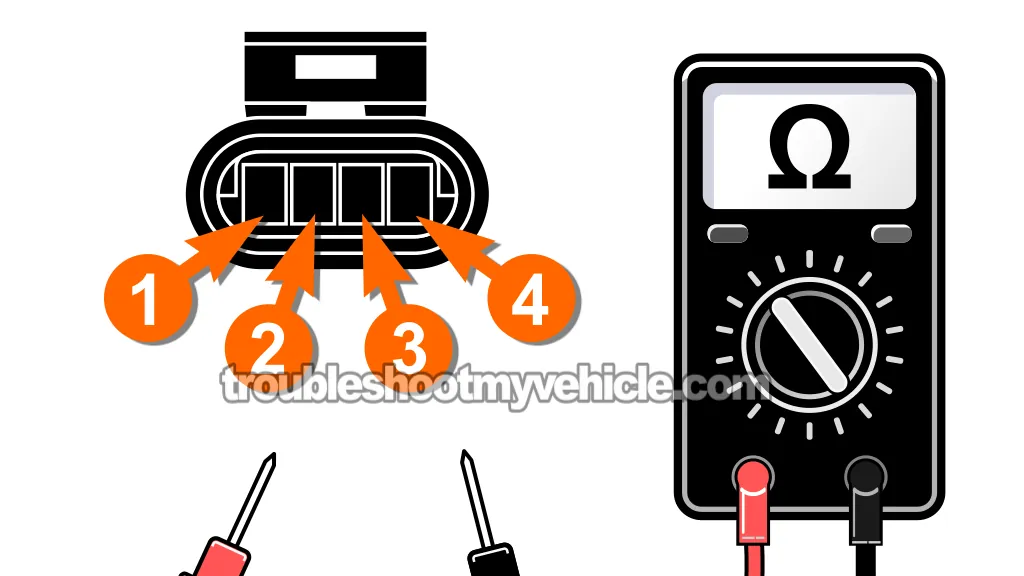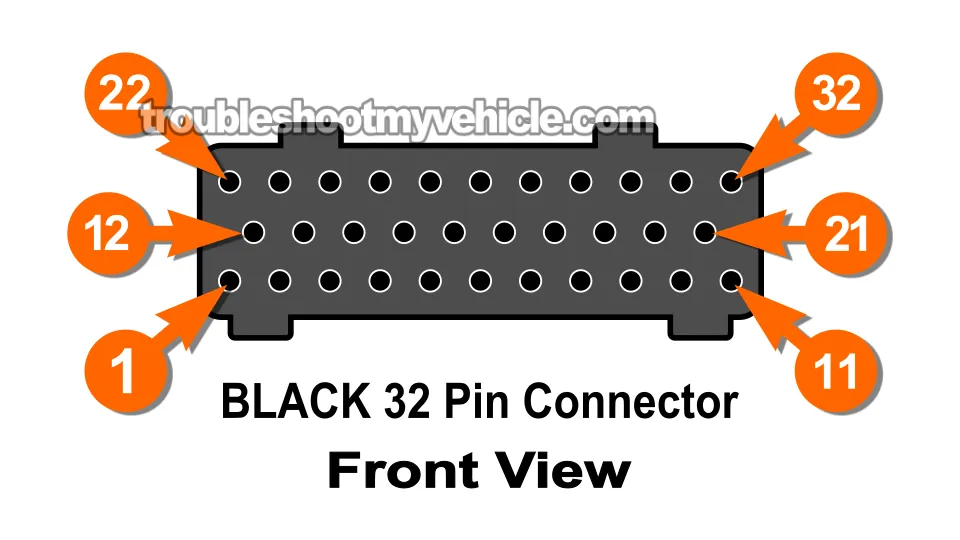TEST 3: Checking The IAC Valve Wires For A Short To Ground

In this test, we're checking whether any of the IAC valve wires are shorted to Ground. Just like in TEST 2, each of the four wires in the IAC connector should be electrically isolated —not only from each other, but also from Ground.
A short to Ground usually happens when the insulation on a wire wears away or gets damaged, allowing the bare copper to touch part of the engine block or another grounded metal surface.
If any wire is shorted to Ground, the PCM won't be able to control the IAC valve properly and will definitely trigger a P0505 code.
To perform this test, we'll place one multimeter lead on each terminal of the IAC connector, one at a time, and the other lead on the engine Ground (via the battery negative cable).
NOTE: Be sure the battery negative (-) cable is disconnected from the battery negative (-) post.
Here are the test steps:
- 1
Disconnect the negative (-) battery cable from the battery post.
We'll use the cable end as your Ground reference in the next steps. - 2
Disconnect the IAC valve connector and the PCM connectors.
NOTE: This ensures you're testing the wiring alone with no interference from the PCM or IAC valve. - 3
Set your multimeter to Ohms mode.
NOTE: Don't use Continuity mode (if your multimeter has one). - 4
Place one multimeter lead on Terminal 1 of the IAC valve connector, and the other lead on the disconnected battery negative (-) cable (your Ground reference).
- 5
Check for continuity.
- 6
The multimeter should read infinite resistance (no continuity).
If it shows low resistance (5 Ohms or less), that wire is shorted to Ground. - 7
Repeat the test for Terminals 2, 3, and 4, one at a time, always checking against Ground.
- 8
Have a helper slowly move and flex the engine wiring harness while you watch the multimeter.
Pay close attention to the sections between the IAC connector and the PCM connector —especially anywhere the harness might rub against brackets or sharp edged engine components. - 9
Watch the multimeter closely for any sudden resistance drops as the harness is moved, flexed, or wiggled.
If the reading suddenly dips to 5 Ohms or lower, that indicates a short-to-Ground —meaning the wire is Grounding out when flexed, confirming an intermittent fault inside the harness.
Let's interpret your test result:
CASE 1: Multimeter shows infinite resistance (no continuity) on all four terminals. This is the correct result. None of the IAC valve wires are shorted to Ground, so the circuits are in good condition.
Proceed to: TEST 4: Checking The IAC Valve Stepper Motor Resistance (From PCM Connector).
CASE 2: Multimeter shows continuity (low resistance) between one or more terminals and Ground. This means that wire is shorted to Ground somewhere between the IAC valve connector and the PCM.
You'll need to inspect the wiring harness, especially where it passes over sharp edges, through brackets, or near hot surfaces. Repair or replace the damaged section. See: How To Repair Shorted IAC Wires (Real-World Fix).
TEST 4: Checking The IAC Valve Stepper Motor Resistance (From PCM Connector)

By this point, we've ruled out wiring damage (TEST 1), shorts between IAC circuits (TEST 2), and shorts to Ground (TEST 3).
The next step is to check the internal health of the IAC valve itself —specifically, the two stepper motors that control the pintle inside the valve.
Each stepper motor has two dedicated wires that run directly to the PCM. We'll be measuring the resistance of each motor by testing the between terminals on the PCM connector.
The resistance value for each motor should be around 35 Ohms although some folks have reported 8-10 Ohms. That number isn't an official spec, but it's the typical ballpark reading you'll see on a good IAC valve.
What really matters is that both stepper motors show similar resistance readings. If one of them is significantly different —or you get an open circuit (infinite resistance) or a short (very low resistance)— then that stepper motor is faulty, and the IAC valve needs to be replaced.
CAUTION: When probing the PCM connector, you must use a probe that is the correct size for the round female terminals. Do NOT force standard multimeter leads into the connector terminal —they are usually too thick and will permanently deform or damage the terminals. If you damage the connector, you may cause poor contact, resulting in unpredictable drivability issues or complete circuit failure. Use a fine-tip back probe or a dedicated terminal test probe. Extreme care is required here.
Here are the test steps:
- 1
Ensure the battery negative cable is still disconnected from the battery post to avoid any voltage at the PCM during testing.
- 2
Reconnect the IAC valve to its 4-wire connector.
This allows you to measure the complete circuit from PCM to IAC and back. - 3
Set your multimeter to its Ohms (Ω) setting.
- 4
To test Stepper Motor 1:
Measure resistance between the black PCM connector terminals 19 and 20.
You should see a reading around 35 Ohms (or 8-10 Ohms). - 5
To test Stepper Motor 2:
Measure resistance between the black PCM connector terminals 10 and 11.
Again, you should get a reading around 35 Ohms (or 8-10 Ohms).
If either motor shows infinite resistance (open circuit) or very low resistance (shorted coil), the IAC valve has failed internally and must be replaced.
Let's interpret your test result:
CASE 1: Both stepper motor circuits show around 35 Ohms (or 8-10 Ohms). This is the correct result.
The IAC valve's internal windings are in good shape, and the problem likely lies elsewhere. Consider checking for carbon buildup inside the valve or a sticking pintle. See also: What If The PCM Itself Is Bad?
CASE 2: One or both readings show infinite resistance (open circuit). This means the stepper motor coil is broken internally. The IAC valve needs to be replaced.
CASE 3: One or both readings show very low resistance (close to 0 Ohms). This indicates a shorted coil inside the IAC valve. Replace the valve —it can no longer respond properly to PCM commands.
What If The PCM Itself Is Bad?
A failed PCM (specifically, the IAC driver circuits inside it) can be the cause of a P0505 code —it happens, but this is extremely rare.
Unfortunately, there's no way to directly test the IAC driver circuits inside the PCM with a multimeter or scan tool.
These driver circuits are solid-state and sealed inside the PCM. When they fail, they stop sending proper control signals to the IAC valve, which can cause rough idle, stalling, or high idle —and trigger the P0505 code.
But here's the important part: you should only suspect a bad PCM after you've ruled out everything else.
This includes:
- The IAC valve has passed resistance and wiring tests.
- No shorts to Ground or between IAC circuits exist.
- Connector pins are in good shape and not loose or corroded.
- The intake manifold gaskets are not leaking.
- No vacuum leaks around the throttle body.
- The throttle plate and bore aren't damaged or sticking.
- The idle stop screw hasn't been tampered with or adjusted.
If —and only if— all of the above have been carefully tested and ruled out, and the idle issue persists with a recurring P0505 code, then it's possible that the PCM has an internal fault.
At that point, the only way to confirm it is to swap in a known-good PCM and recheck idle operation. If the problem goes away, you've found your culprit.
Again, PCM failure is extremely rare. So always assume the problem is in the wiring, IAC valve, or a mechanical issue first —and only suspect the PCM when there's truly nothing else left to blame.
How To Repair Shorted IAC Wires (Real-World Fix)
Once you've confirmed that two IAC wires are shorted together —and the damaged section is hidden somewhere inside the engine wiring harness where it's not visible— there's no need to open up the entire harness and manually trace each wire end to end. That's simply not how it's done in real-world diagnostics.
Instead, the most effective and long-term fix is to bypass the bad section of wire completely by splicing in a new one.
Here's how it's typically done:
- Cut the affected wire(s) at least 3 to 4 inches away from the IAC valve connector.
- Do the same at the PCM connector end —give yourself a few inches of clean, undamaged wire to work with.
- Use wire of the same gauge and insulation type as the original. Strip the ends and solder the new wire in place.
- Never use butt connectors. They often seem fine at first, but over time, they loosen due to engine vibration or bumps in the road. This leads to intermittent or false connections that can be frustrating to track down later.
- Once soldered, protect the repair with heat shrink tubing or high-quality electrical tape to ensure durability and prevent moisture intrusion.
The ideal fix is to replace the entire engine harness, but in reality, that's expensive and rarely necessary. Splicing in new wire sections as described above is a professional-level repair that holds up long-term when done correctly.
This method restores full circuit integrity and allows the PCM to properly control the IAC valve —eliminating the cause of the P0505 code if the wiring fault was to blame.
More 5.2L, 5.9L V8 Dodge Ram Pickup Tutorials
I've written several more tutorials for the V8 Dodge Ram pickups that may be of interest to you that you can find in this index:
Here's a sample of the tutorials you'll find in the index:
- How To Test The Fuel Pump (1992-2003 5.2L, 5.9L V8 Dodge Ram Pickup).
- How To Test The Intake Air Temp (IAT) Sensor (1998-2003 5.2L, 5.9L V8 Dodge Ram Pickup).
- How To Test The Camshaft Position Sensor (1998-2003 5.2L, 5.9L V8 Dodge Ram Pickup).
- Troubleshooting A Blown Head Gasket (1989-2003 5.2L, 5.9L V8 Dodge Ram Pickup).

If this info saved the day, buy me a beer!

